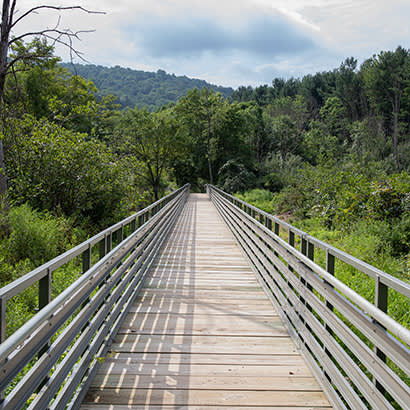
For an enhanced digital experience, read this story in the ezine.
Rocky Gap State Park — located in Maryland’s Allegany County — is a breathtaking 3,000-acre state park. The park features beautiful, rugged mountains, a dense hemlock forest, and the picturesque Lake Habeeb, known for what many call the “bluest water in the state.” It’s safe to say that Rocky Gap State Park provides a unique and memorable experience for all its visitors to enjoy.
For park officials, a walking trail that allowed visitors to enjoy the beauty of Rocky Gap State Park’s scenic 243-acre Lake Habeeb posed a safety concern by crossing over a vehicle access road. Even with drivers maintaining safe speeds and driving cautiously, there’s always a risk of danger when there’s heavy pedestrian traffic on a road created for vehicles. Park officials took aim at creating a safer walking environment for pedestrians — and getting them off the road.
Rocky Gap State Park partnered with Excavating Associates and Bedford Reinforced Plastics to reroute pedestrians to a safer trail. Park officials needed a pedestrian bridge to integrate into its picturesque nature trail system that looped around the lake, choosing to install a fiberglass-reinforced plastic (FRP) pedestrian bridge. The teams collectively developed a 200-linear-foot FRP bridge and boardwalk system that seamlessly integrated with the trail around the lake and allowed hikers and bikers to get off the road and continue safely on the trail.
“We designed a pedestrian bridge that was located between a boardwalk system. The FRP bridge is a 40’ by 5’ pedestrian bridge and then we have sections of 10’ by 5’ boardwalks installed end to end,” says Ted Harris, Bedford ReadySpan account manager.
The bridge was installed within one day, and there was no need for additional labor costs or welding expenses — in part because FRP material is lighter weight than both steel and aluminum. Bridge parts are cut to size and pre-drilled, and all hardware is shipped along with the parts.
“The Rocky Gap State Park bridge was assembled onsite,” says Gerry Scritchfield of Excavating Associates. “Then we transported it close to the final location, set it into position and anchored it down.”
In addition to the quick installation timeline, the impact of installing the bridge was minimal — not disturbing the earth and plant growth around the area — which is a priority within parks and public land. Park officials also have been thrilled with the aesthetic appeal of the bridge color chosen to blend with the natural surroundings.
“Rocky Gap State Park wanted a system that is going to look really good in its surrounding[s] and blend in with the natural area,” says Harris. “They wanted a solution that was lightweight, cost effective and easy to install. They didn’t want to have to do periodic maintenance on the bridge or come back and paint the bridge or replace rotten wood.”
In addition to its aesthetic, the bridge is also durable by design. FRP is a hard-wearing, long-lasting, maintenance-free material that performs very well compared to steel and wood in coastal or lakeshore areas, like Lake Habeeb, due to its corrosion resistance.
When it comes to bridges, safety is a primary concern. The bridge was designed for a pedestrian load of 85 pounds per square foot and a snow load of 55 pounds per square foot. It also can handle a wind load of 25 pounds per square foot and is designed for seismic loads as well. In addition to pedestrian foot traffic, the bridge also can withstand ATV traffic.
Another one of Rocky Gap State Park’s primary concerns was to ensure that their new bridge was in compliance with the Americans with Disabilities Act (ADA). This bridge meets ADA specifications, featuring a boardwalk with ADA-compliant hand railings on both sides, as well as safety rails, to ensure a safe, memorable time for all who visit.
Eric Kidd is Marketing Director of Bedford Reinforced Plastics, Inc.


